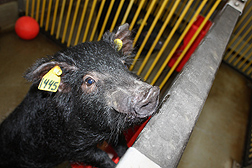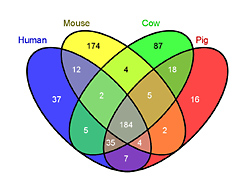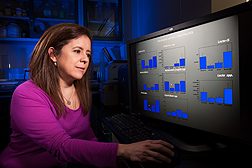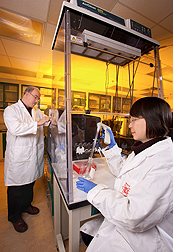Pigs Useful in Immune and Obesity Research
Nutritionist Harry Dawson and microbiologist Gloria Solano-Aguilar, both scientists at the Agricultural Research Service’s Beltsville [Maryland] Human Nutrition Research Center (BHNRC), have teamed with scientists from ARS and other organizations to use the pig as an animal model to promote both human and animal health. This research focuses on assessing the effect of nutrition on immune and inflammatory responses.
Dawson helped develop and continues to curate the publicly available Porcine Translational Research Database of genes and proteins for comparison with those prominently studied in rodents and humans. “This database contains functional information on more than 5,800 genes commonly studied in humans, pigs, and mice, including about 2,240 that have been sequenced at BHNRC.” The database can be found at tinyurl.com/porcinedata.
The database contains “manually annotated” genes, meaning that all genes and protein sequences included in the database, as well as information about their functions, were manually entered. Annotated genes can also be entered by computer software programs that predict the structure and identity of genes and proteins based on algorithms.
“These computer programs, while fast, are prone to error that can be corrected only by manual annotation,” says Dawson.
Immune System Similarities
In addition, Dawson conducted a comparative analysis and assessment of specific portions of the swine, mouse, and human genomes. He found that humans share far more immune-system-related genes and proteins with pigs than they do with mice. He reported that when a functional part of a protein is missing among one of the three species, the chance that it is preserved only in pigs and humans is nearly two times greater than the chance it is preserved only in mice and humans. Dawson’s book chapter, “A Comparative Assessment of the Pig, Mouse, and Human Genomes,” was published by CRC Press in 2011 in The Minipig in Biomedical Research.
The first complete pig genome sequence, version Sscrofa 10.2, was released by the Swine Genome Sequencing Consortium in 2012. As part of that effort, a subgroup called the “Immune Response Annotation Group” annotated more than 1,400 swine genes involved in the animal’s immune response. This group included ARS’s Dawson, molecular biologist Celine Chen, chemist Joan Lunney, and others.
The group discovered that the immunity genes of pigs and humans are very similar and evolve at a similar rate in both species. These findings were reported in the journal Nature in 2012.
Later, the group published a study that further characterized the structure and function of the porcine immunome. An immunome is a collection, or reference set, of immune-system-related genes and proteins of a given species. The group provided new immune-response annotations for more than 500 porcine genes and 3,472 protein-coding transcripts.
“The porcine genome is not yet complete, and additional genes may be discovered,” says Dawson. “But these comprehensive and integrated analyses provide important tools for measuring the porcine immune response.” The findings were published in BMC Genomics in 2013.
These comparative studies provide compelling evidence for using swine in research on both human and animal health, says Dawson. “These studies indicate that pigs are a good species to further test concepts and principles that have been discovered by first using mice as a model, particularly for immune-response research.”
Obesity Research Goes to the Hogs
Also at the BHNRC, Solano-Aguilar has worked on a series of studies showing that the pig is instrumental as a model for human obesity-related research. She worked with Kati Hanhineva, of the University of Eastern Finland in Kuopio, to study metabolic changes that occur in pig tissues and biofluids after the pigs consumed a high-fat diet.
The researchers studied the Ossabaw pig because it has a greater tendency to deposit excess fat and develop obesity-related diseases when fed a high-calorie diet, compared to other pig breeds. The emphasis was on using juvenile pigs as a model for obesity in children. “This is an important area because it is generally difficult to evaluate obesity-related metabolic disturbances in children,” says Solano-Aguilar.
|
|
The authors wanted to study diet-induced metabolic changes taking place in the tissues they collected from the pigs—liver, pancreas, brain, and intestine. And they wanted to compare whether the changes they found in the tissues were also present in the pig’s urine and plasma—biofluids that are typically collected during human clinical studies.
The study pigs were fed either a maintenance diet or a high-fat diet. The researchers found changes in lipid metabolites in all analyzed host tissue samples from the pigs fed the high-fat diet. Some tissue-dependent changes were not reflected in the biofluids.
Using swine as a biomedical research model was useful for studying metabolic effects induced by a high-fat diet, says Joseph Urban, a coauthor at the BHNRC laboratory who initiated a multi-institute cooperative agreement with the Finnish scientists.
“Biofluids give us part of the picture,” Urban says, “but being able to look at organ tissue helped us target changes that are indicative of both disease and poor response to diet.”
The study was published in the Journal of Proteome Research in 2013.—By Rosalie Marion Bliss, Agricultural Research Service Information Staff.
This research is part of Human Nutrition (#107) and Animal Health (#103), two ARS national programs described at www.nps.ars.usda.gov.
Harry Dawson and Gloria Solano-Aguilar are with the USDA-ARS Diet, Genomics, and Immunology Laboratory, 10300 Baltimore Ave., Beltsville, MD 20705-2350; (301) 504-9412, ext. 278 [Dawson], (301) 504-8068, ext. 295 [Solano-Aguilar].
"Pigs Useful in Immune and Obesity Research" was published in the May/June 2014 issue of Agricultural Research magazine.










